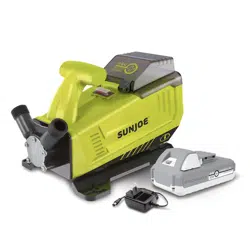Loading ...
Loading ...

3
15. Do not incinerate the battery even if it is severely
damaged. The batteries can explode in a re.
16. To reduce the risk of re or electric shock, do not use this
product with any solid-state speed control device.
17. To reduce the risk of personal injury and electric shock,
the product should not be played with or placed where
small children can reach it.
18. To reduce the risk of electric shock, do not expose to
water or rain.
19. Not for potable water or other potable liquids.
20.
Do not pump water with a temperature over 104°F (40°C).
Do not pump sand, particulate, or large debris. Damage to
the pump will occur.
21.
Do not allow this pump to operate unattended. Failure to
follow this warning could result in personal injury.
22.
Do not pump water from a creek, pond, or source where
foreign objects may be sucked into the pump. Solids may
enter the inlet hose.
23.
Secure the discharge hose before starting the pump.
An unsecured discharge hose may whip. Personal injury
and/or death could result.
Service
1. Have servicing performed by a qualied repair person
using only identical replacement parts. This will ensure
that the safety of the product is maintained.
2. When servicing the product, use only identical
replacement parts. Follow instructions in the Maintenance
section of this manual. Use of unauthorized parts or failure
to follow Maintenance Instructions may create a risk of
shock or injury.
Battery + Charger
Safety Instructions
NOTE: This unit is tool only. The battery and the charger are
not included. They must be purchased separately.
Model 24V-XFP5-CT is compatible with the iON+ 24V System
batteries and chargers. See page 15 for more information.
We pay a great deal of attention to the design of every battery
pack to ensure that we supply you with batteries that are safe,
durable and have a high energy density. The battery cells have
a wide range of safety devices. Each individual cell is initially
formatted and its electrical characteristic curves are recorded.
This data is then used exclusively to be able to assemble the
best possible battery packs.
Despite all the safety precautions, caution must always be
exercised when handling the battery. The following points must
be obeyed at all times to ensure safe use. Safe use can only
be guaranteed if undamaged cells are used. Incorrect handling
of the battery pack can cause cell damage.
IMPORTANT! Analyses conrm that incorrect use and poor
care of high-performance batteries are the main factors
responsible for personal and/or product damage.
mWARNING! Use only approved replacement batteries;
other batteries may damage the cordless transfer pump and
cause it to malfunction, which can lead to serious personal
injury.
mWARNING! Do not use a battery pack or appliance that
is damaged or modied. Damaged or modied battery may
exhibit unpredictable behavior resulting in re, explosion or risk
of injury.
Do not modify or attempt to repair the appliance or the battery
pack except as indicated in the instructions for use and care.
Have your battery pack serviced by a qualied repair person
using only identical replacement parts. This will ensure that the
safety of the battery pack is maintained.
mCAUTION! To reduce the risk of injury, charge the 24V
iON+ lithium-ion battery pack only in the designated 24V iON+
lithium-ion charger. Other types of chargers present risk of re,
personal injury and damage. Do not wire the battery pack to
a power supply plug or car cigarette lighter. Such misuse will
permanently disable or damage the battery pack.
• Avoid dangerous environments – Do not charge the
battery pack in rain, snow or in damp or wet locations.
Do not use the battery pack or charger in the presence of
explosive atmospheres (gaseous fumes, dust or ammable
materials) because sparks may be generated when
connecting or disconnecting the battery pack, which could
lead to a re.
• Charge in a well-ventilated area – Do not block the
charger vents. Keep them clear to allow for proper
ventilation. Do not allow smoking or open ames near a
charging battery pack. Vented gases may explode.
NOTE: The safe temperature range for the battery is 41°F –
105ºF (5°C – 40.5°C). Do not charge the battery outside in
freezing weather; charge it at room temperature.
• Maintain charger cord – When unplugging the charger, pull
the plug, not the cord, from the receptacle to reduce the
risk of damage to the electrical plug and cord. Never carry
the charger by its cord or yank it by the cord to disconnect
it from the receptacle. Keep the cord away from heat, oil
and sharp edges. Make sure the cord will not be stepped
on, tripped over or subjected to damage or stress when the
charger is in use. Do not use the charger with a damaged
cord or plug. Replace a damaged charger immediately.
• Do not use an extension cord unless it is absolutely
necessary – Using the wrong, damaged or improperly
wired extension cord poses a risk of re and electric shock.
If an extension cord must be used, plug the charger into a
properly wired 16 gauge or larger extension cord with the
female plug matching the male plug on the charger. Make
sure that the extension cord is in good electrical condition.
Loading ...
Loading ...
Loading ...
